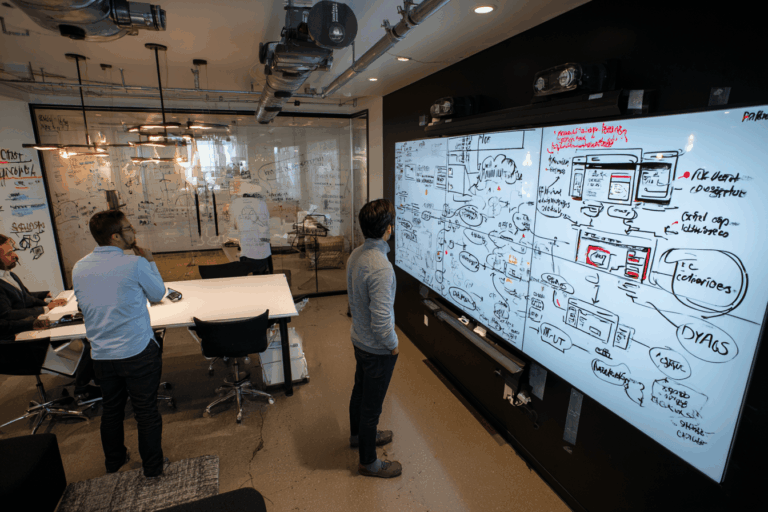Local Business GEO: Dominate AI “Near Me” Searches
Introduction and Overview
In today’s digital landscape, the way consumers find local businesses has undergone a dramatic transformation. With the rise of AI-powered search engines and voice assistants, traditional SEO strategies are no longer sufficient. Welcome to the era of Generative Engine Optimization (GEO) – the next frontier in digital marketing that focuses on optimizing content for AI-driven search experiences.
As of mid-2025, nearly 65% of local business searches now happen through AI interfaces that prioritize different signals than traditional search engines. This shift demands a new approach: generative engine optimization services that help businesses adapt to and thrive in this AI-centric environment.
This guide explores how local businesses can leverage generative engine optimization services to dominate “near me” searches, capture more qualified leads, and stay ahead of competitors who are still relying solely on traditional SEO methods.
Key Concepts and Fundamentals
Understanding Generative Engine Optimization (GEO)
Generative Engine Optimization (GEO) differs fundamentally from traditional SEO in several key ways:
- Intent-Focused vs. Keyword-Focused: While traditional SEO prioritizes specific keywords, GEO focuses on understanding and addressing user intent through natural language processing.
- Conversational Queries: AI search interfaces process longer, more conversational queries rather than short keyword phrases.
- Entity Recognition: AI search engines understand entities (people, places, things) and their relationships rather than just matching keywords.
- Local Context Awareness: Modern AI systems factor in precise location data, local preferences, and even time of day when delivering results.
- Multimodal Inputs: Today’s AI search interfaces accept voice, text, images, and even gesture inputs, requiring optimization across multiple modalities.
The Local Business AI Search Ecosystem
For local businesses, the AI search ecosystem in 2025 includes:
- Voice Assistants: Google Assistant, Siri, Alexa, and newer players like Claude Companion
- AI-Enhanced Maps: Google Maps AI, Apple Maps Concierge, and Meta Local Guide
- Visual Search Tools: Google Lens, Snap Scan, and Instagram Spot Finder
- Integrated Vehicle Systems: Tesla Navigation AI, Apple CarOS, and Android Auto Assistant
- Wearable Devices: Smart glasses, watches, and other wearables with integrated AI search
Each of these platforms has unique characteristics that require specific optimization strategies.
Step-by-Step Implementation
1. Audit Your Current Digital Presence
Before implementing generative engine optimization services, assess your current digital footprint:
- Business Listing Consistency: Verify your business name, address, phone number (NAP) consistency across all platforms
- AI Readability Assessment: Test how well AI systems can extract key information from your website
- Competitive Analysis: Analyze how competitors appear in AI-driven search results
- Voice Search Testing: Test how your business information appears in voice search results
Implementation Tool:
Use the GEO Audit Framework to score your current presence:
| Element | Score (1-10) | Priority |
|---|---|---|
| NAP Consistency | ||
| AI-Readable Content | ||
| Schema Implementation | ||
| Voice Search Visibility | ||
| Local Review Quality |
2. Implement Structured Data for AI Understanding
AI systems rely heavily on structured data to understand your business:
- LocalBusiness Schema: Implement comprehensive LocalBusiness schema markup with all relevant attributes
- Service Schema: Detail your services using the Service schema type
- Product Schema: For retail businesses, implement Product schema for inventory
- FAQ Schema: Add FAQ schema to address common customer questions
- Event Schema: For businesses hosting events, implement Event schema
<script type="application/ld+json">
{
"@context": "https://schema.org",
"@type": "LocalBusiness",
"name": "Your Business Name",
"image": "https://yourbusiness.com/images/logo.png",
"address": {
"@type": "PostalAddress",
"streetAddress": "123 Main Street",
"addressLocality": "Your City",
"addressRegion": "State",
"postalCode": "12345",
"addressCountry": "US"
},
"geo": {
"@type": "GeoCoordinates",
"latitude": 40.7128,
"longitude": -74.0060
},
"priceRange": "$$",
"telephone": "+1-123-456-7890",
"openingHoursSpecification": [
// Opening hours details
]
}
</script>
3. Develop AI-Optimized Content
Create content specifically designed for AI comprehension:
- Natural Language Q&A Format: Structure content as questions and answers that match conversational queries
- Location-Specific Pages: Create neighborhood-specific landing pages with local landmarks and references
- Semantic Relationship Building: Connect your business to related local entities and concepts
- Multimodal Content: Develop content in multiple formats (text, audio, video) with proper tagging
4. Build a Local Entity Network
Strengthen your business’s position in the local entity graph:
- Local Business Partnerships: Create digital connections with complementary local businesses
- Community Organization Relationships: Establish digital links with chambers of commerce and community groups
- Local Event Participation: Document participation in local events with proper tagging
- Neighborhood Landmarks: Reference nearby landmarks in your content to strengthen geographic associations
Best Practices and Tips
Optimize for Conversational Queries
Unlike traditional keyword optimization, conversational query optimization requires:
- Long-tail Question Phrases: Incorporate full questions that match how people speak to AI assistants
- Natural Answer Formatting: Structure answers in natural, conversational language
- Context Awareness: Include time-sensitive information (seasonal offerings, holiday hours)
- Personalization Signals: Allow for personalized responses based on user history and preferences
Leverage AI-Enhanced Reviews
Reviews play a crucial role in generative engine optimization services:
- Review Generation Strategy: Implement a systematic approach to gathering detailed, specific reviews
- AI-Readable Review Responses: Respond to reviews in a way that AI systems can understand and extract meaning from
- Sentiment Analysis Optimization: Monitor and improve the sentiment analysis scores of your reviews
- Review Highlight Extraction: Format reviews to help AI systems extract key highlights
Implement Visual Search Optimization
With the rise of visual search in “near me” queries:
- Business Imagery Tagging: Properly tag all business images with descriptive alt text and structured data
- Image Consistency: Maintain consistent visual branding across all platforms
- Visual Search Testing: Regularly test how your business appears in visual search results
- 360° Virtual Tours: Implement Google Business Profile virtual tours with proper tagging
Common Mistakes to Avoid
Overoptimization Pitfalls
Avoid these common overoptimization mistakes that can harm your AI search visibility:
- Keyword Stuffing in Schema: Adding excessive keywords to structured data
- Fake or Manipulated Reviews: Attempting to game the review system
- Inconsistent NAP Information: Having different business information across platforms
- Neglecting Voice Search Patterns: Optimizing only for text-based searches
- Ignoring Local Context: Creating generic content that doesn’t reflect local nuances
Technical Implementation Errors
Watch out for these technical mistakes:
- Incomplete Schema Implementation: Missing crucial structured data elements
- Poor Mobile Experience: Neglecting the mobile user experience (critical for on-the-go searches)
- Slow Loading Times: Having pages that load too slowly for AI crawlers
- Blocked AI Crawlers: Inadvertently blocking AI crawlers in robots.txt
- Unoptimized Images: Using images without proper compression and tagging
Advanced Strategies
AI Interaction Pattern Optimization
For businesses ready to take generative engine optimization services to the next level:
- Conversation Flow Mapping: Design content that anticipates multi-turn conversations with AI assistants
- Intent Disambiguation: Create content that helps AI systems disambiguate between similar intents
- Cross-Platform Consistency: Ensure consistent information and experiences across all AI platforms
- Predictive Query Modeling: Anticipate and optimize for future queries based on customer journey mapping
Local AI Knowledge Graph Development
Build your own local knowledge graph to strengthen your position:
- Local Entity Database: Create and maintain a database of local entities related to your business
- Relationship Mapping: Document relationships between your business and other local entities
- Temporal Context Addition: Add time-based context to your entity relationships
- Semantic Networking: Connect your business to broader semantic networks relevant to your industry
Conclusion and Next Steps
The shift to AI-driven search has fundamentally changed how local businesses need to approach digital marketing. By implementing comprehensive generative engine optimization services, your business can gain a significant competitive advantage in “near me” searches.
Remember that GEO is an ongoing process, not a one-time implementation. The AI search landscape continues to evolve rapidly, with new capabilities and platforms emerging regularly.
Action Items for Implementation
- Conduct a GEO Audit: Assess your current AI search visibility using the framework provided
- Implement Core Schema Markup: Add comprehensive structured data to your website
- Develop an AI Content Strategy: Create content specifically designed for AI comprehension
- Build Local Entity Relationships: Strengthen your position in the local knowledge graph
- Monitor and Adapt: Set up regular monitoring of your AI search performance and adapt as needed
By following this guide, you’ll be well-positioned to dominate “near me” AI searches and capture the growing segment of customers who rely on AI assistants to find local businesses.






